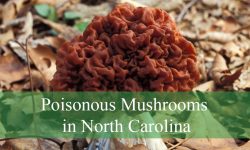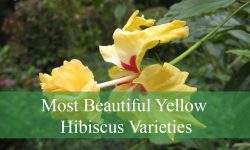Evergreen trees are a staple in many landscapes, providing year-round beauty and structure to gardens, parks, and forests. With their lush, green foliage that persists through all seasons, they offer both aesthetic value and practical benefits, such as windbreaks and privacy screens. Understanding the different types of evergreen trees can help you select the right tree for your outdoor space, whether you’re looking for shade, beauty, or environmental advantages.
In this guide, we’ll explore 45 types of evergreen trees, showcasing a variety of species from towering pines to compact shrubs. Each tree has unique characteristics, from needle and leaf shapes to bark textures, making identification an essential skill for gardeners and nature enthusiasts alike. This list will help both experienced arborists and beginner gardeners recognize and appreciate the diverse world of evergreen trees.
From majestic pines and spruces to more ornamental varieties like hollies and yews, the types of evergreen trees you’ll discover here can thrive in a range of climates and soil conditions. This comprehensive list will serve as a helpful resource for selecting the best evergreens to suit your needs and growing environment, so let’s dive into the details and learn about these remarkable trees.
Different Types of Evergreen Trees
Boxwood (Buxus sempervirens)
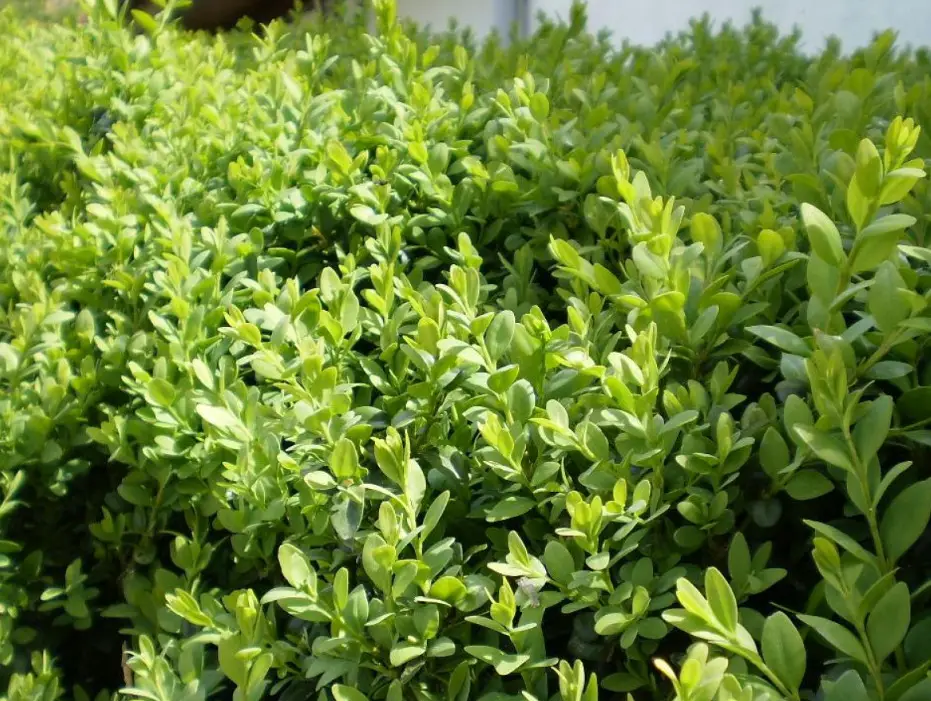
Boxwood is a dense, slow-growing evergreen shrub well known for its small, glossy, dark green leaves and refined appearance. This plant naturally grows in a rounded form and can be easily shaped into topiaries or hedges, making it a favorite for formal gardens and borders. Boxwood emits a mild, earthy scent, particularly after rain or pruning.
You can identify boxwood by its small, leathery, oval-shaped leaves that grow opposite each other. The foliage remains vibrant throughout the year, providing year-round structure and greenery in landscape designs. While typically found as a shrub, some varieties can grow into small trees when untrimmed.
Boxwood thrives in USDA hardiness zones 5 through 9 and prefers well-drained, slightly alkaline soil with partial to full sun exposure. To maintain its shape and health, prune in late winter or early spring before new growth appears. Keep the roots cool and moist with mulch, and avoid overwatering to prevent root rot.
Leyland Cypress (× Cuprocyparis leylandii)

Leyland Cypress is a fast-growing evergreen tree prized for its tall, conical shape and soft, feathery foliage. Its rapid growth rate—up to 3 feet per year—makes it ideal for privacy screens, windbreaks, and large hedges. The foliage is a muted greenish-gray and forms dense, overlapping sprays.
This tree is easily identified by its flattened, scale-like leaves and upright branching habit. It grows quickly and uniformly, typically reaching heights of 60 to 70 feet with a spread of 15 to 25 feet. Though beautiful, Leyland Cypress requires room to grow and can become too large for small spaces.
Hardy in USDA zones 6 through 10, Leyland Cypress prefers full sun and well-drained soil. It tolerates a variety of soil types but struggles in areas with poor drainage or high humidity. Minimal pruning is needed aside from height control, and it should be watered regularly during establishment. Once mature, it becomes relatively drought-tolerant.
Eastern White Pine (Pinus strobus)
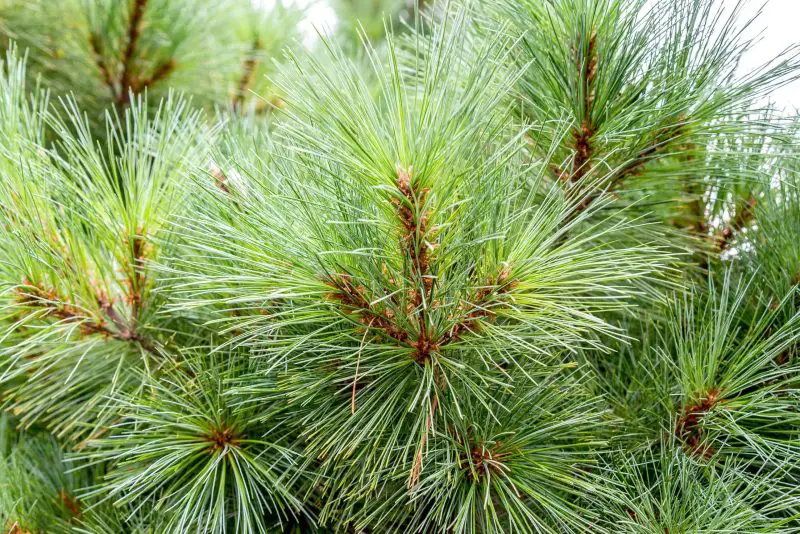
Eastern White Pine is a majestic native conifer with soft, bluish-green needles that grow in bundles of five. This species is known for its tall, straight trunk and gracefully tiered branches, giving it a soft, feathery appearance. It’s commonly used as a specimen tree or for reforestation and timber.
You can recognize the Eastern White Pine by its long needles (up to 5 inches), flexible twigs, and elongated cones that can be up to 8 inches long. As it matures, the tree forms a broad, irregular crown and can reach heights of 80 to 100 feet in the wild.
It grows best in USDA zones 3 through 8 and prefers full sun with moist, well-drained acidic soil. Although it tolerates a range of conditions, it should be protected from strong winds and heavy air pollution. Regular mulching and deep watering during dry periods support healthy growth.
Blue Spruce (Picea pungens)
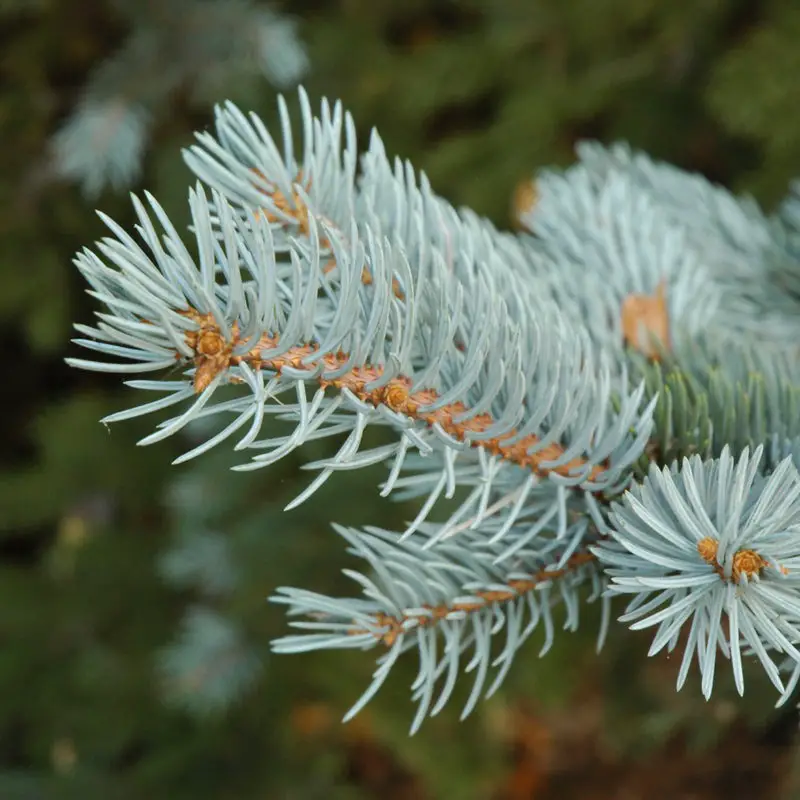
The Blue Spruce, also known as Colorado Spruce, is an iconic evergreen admired for its silvery-blue to blue-green needles and symmetrical pyramid shape. Its striking color and stiff, sharp needles make it a popular ornamental tree in residential and public landscapes.
This tree is easily recognized by its stiff, square-shaped needles that are approximately 1 inch long and emit a strong pine scent when crushed. It produces attractive, cylindrical cones and maintains a dense, uniform structure, which adds architectural interest year-round.
Blue Spruce grows well in USDA zones 2 through 7 and thrives in full sun with well-drained soil. It is drought-tolerant once established but can be prone to needle cast diseases if exposed to high humidity or poor airflow. Regular monitoring and spacing for air circulation are key to its care.
Douglas Fir (Pseudotsuga menziesii)
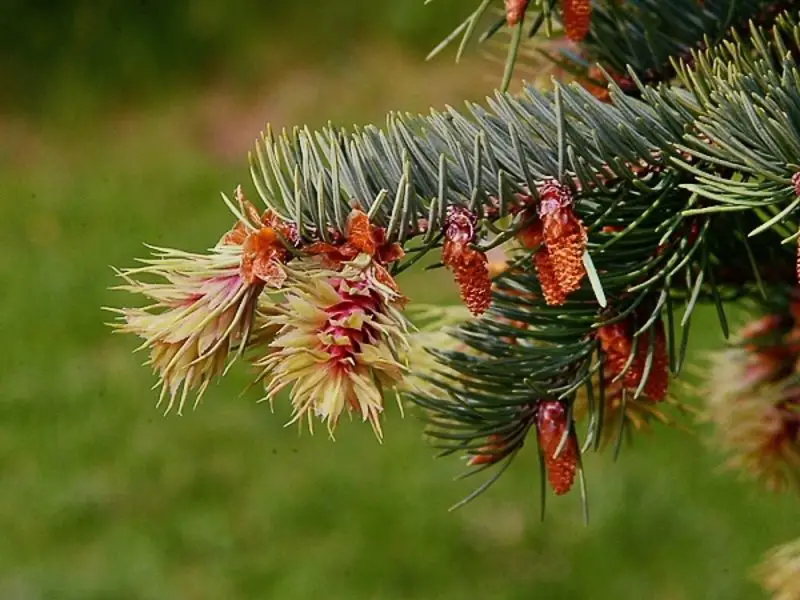
Douglas Fir is one of the tallest and most important timber trees in North America, known for its soft, fragrant needles and robust trunk. Although technically not a true fir, it shares similar coniferous characteristics and is often used as a Christmas tree or in natural woodland landscapes.
It is distinguishable by its flat, flexible needles arranged in a spiral, and by its unique cones with protruding, three-pointed bracts resembling mouse tails. The bark on mature trees becomes thick and deeply furrowed, adding to its rugged aesthetic.
Thriving in USDA zones 4 through 6, Douglas Fir prefers deep, well-drained soils in full sun to partial shade. It requires minimal pruning and benefits from mulching around its base. Avoid planting in compacted or waterlogged soils to maintain its vigor and longevity.
Southern Magnolia (Magnolia grandiflora)
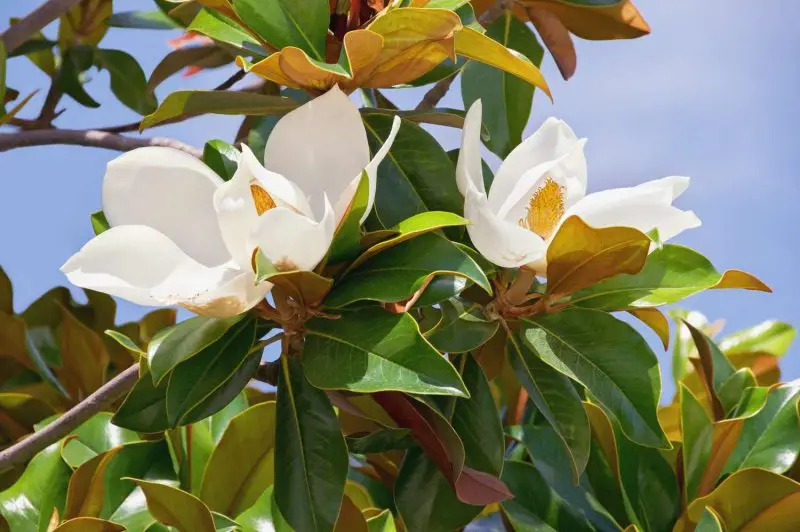
Southern Magnolia is a classic broadleaf evergreen tree admired for its large, leathery leaves and showy white flowers. These fragrant blooms can reach up to 12 inches in diameter and appear in late spring to early summer, making the tree a stunning focal point.
This species is easy to identify by its dark green leaves with a rust-colored, fuzzy underside and large, creamy-white blossoms. The tree forms a dense, pyramidal canopy and typically grows to heights of 60 to 80 feet, although dwarf cultivars are also available for smaller landscapes.
Southern Magnolia is best suited to USDA zones 6 through 10 and thrives in full sun or partial shade with moist, well-drained, slightly acidic soil. It appreciates consistent moisture and a mulch layer to protect the roots. Minimal pruning is needed, though young trees may need shaping to develop a strong central leader.
Eastern Red Cedar (Juniperus virginiana)
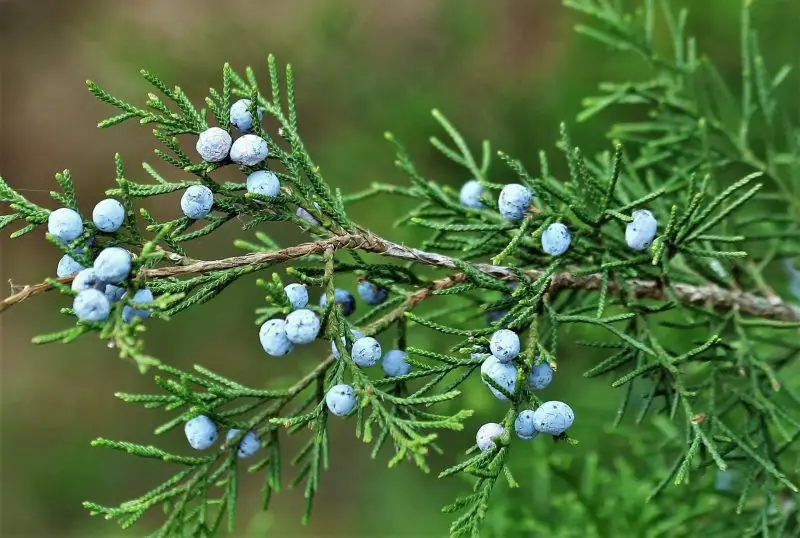
Eastern Red Cedar is a hardy, aromatic evergreen native to eastern North America. It features scale-like foliage that ranges in color from deep green to bluish-green, and it often has a columnar or pyramidal shape. This tree is valued for its dense wood, which is rot-resistant and commonly used for fence posts and cedar chests.
It can be identified by its reddish-brown, shredding bark and the small, blue-gray, berry-like cones it produces. These “berries” are actually modified cones and serve as a vital food source for birds. The foliage can take on a bronze hue in winter, especially in colder regions.
Hardy in USDA zones 2 through 9, Eastern Red Cedar thrives in full sun and is tolerant of a wide range of soils, including dry, rocky, or poor soils. It is drought-tolerant once established and requires very little maintenance. Regular pruning is not necessary unless shaping is desired.
Western Red Cedar (Thuja plicata)
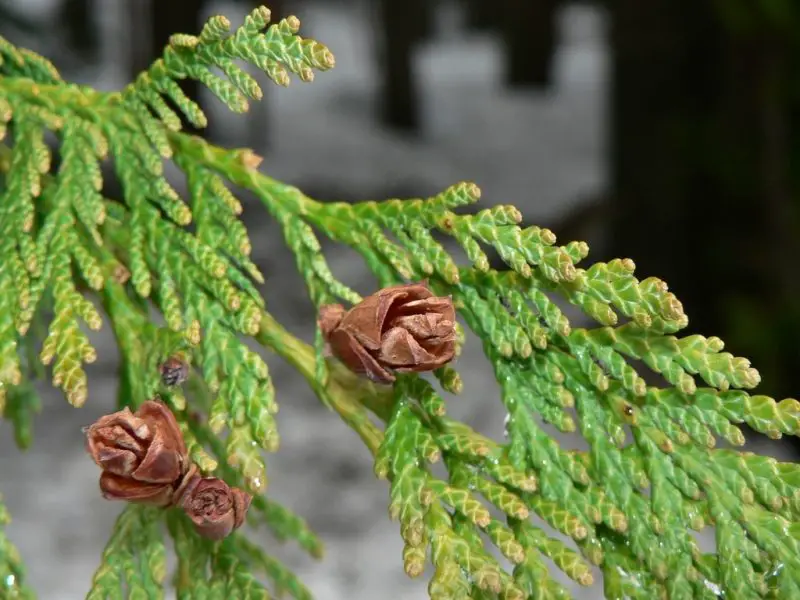
Western Red Cedar is a majestic evergreen tree known for its scale-like foliage, reddish-brown bark, and aromatic wood. It can grow to impressive heights of 150 feet in its native Pacific Northwest range and is often used for privacy screens, windbreaks, or as a specimen tree.
It can be identified by its lacy, flattened sprays of foliage and fibrous bark that peels in long strips. The foliage emits a pleasant, cedar-like scent when crushed, and the tree produces small, woody cones that add ornamental interest. Its graceful, drooping branch tips give it a layered appearance.
Western Red Cedar thrives in USDA zones 5 through 8 and prefers moist, well-drained soils in full sun to partial shade. It benefits from consistent watering during dry periods and performs best in cool, humid climates. Mulching around the base helps retain soil moisture and keeps roots cool.
Northern White Cedar (Thuja occidentalis)
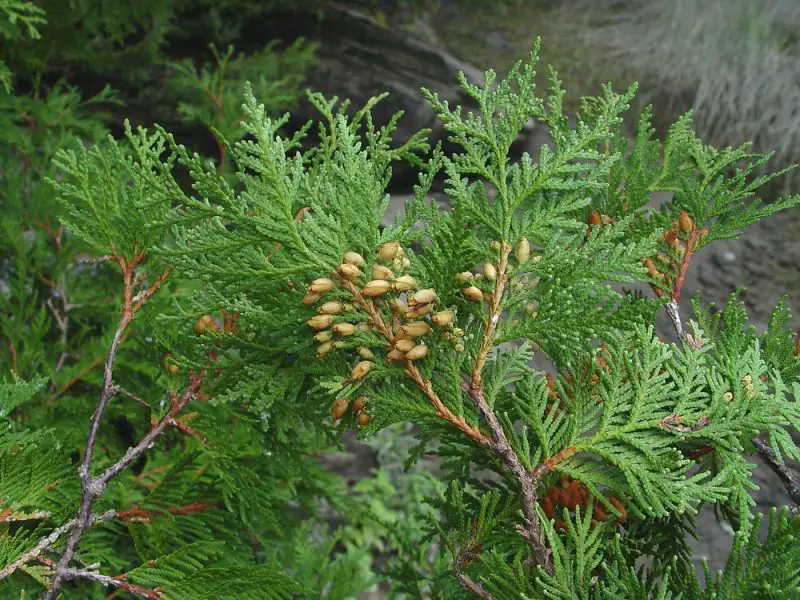
Northern White Cedar, also called Eastern Arborvitae, is a popular landscape evergreen with soft, scale-like foliage and a conical growth habit. It’s often used for hedges, privacy screens, and foundation plantings due to its dense form and adaptability to shearing.
This species features fan-shaped sprays of light green foliage and reddish-brown bark that peels in narrow strips. It produces small, upright cones that are about half an inch long. Dwarf and columnar cultivars are widely available, making it suitable for both large and compact gardens.
Hardy in USDA zones 2 through 7, Northern White Cedar grows best in full sun to partial shade with moist, well-drained soil. It prefers slightly alkaline conditions and benefits from mulching to maintain root moisture. Prune annually to control shape and remove any dead or broken branches.
Fraser Fir (Abies fraseri)
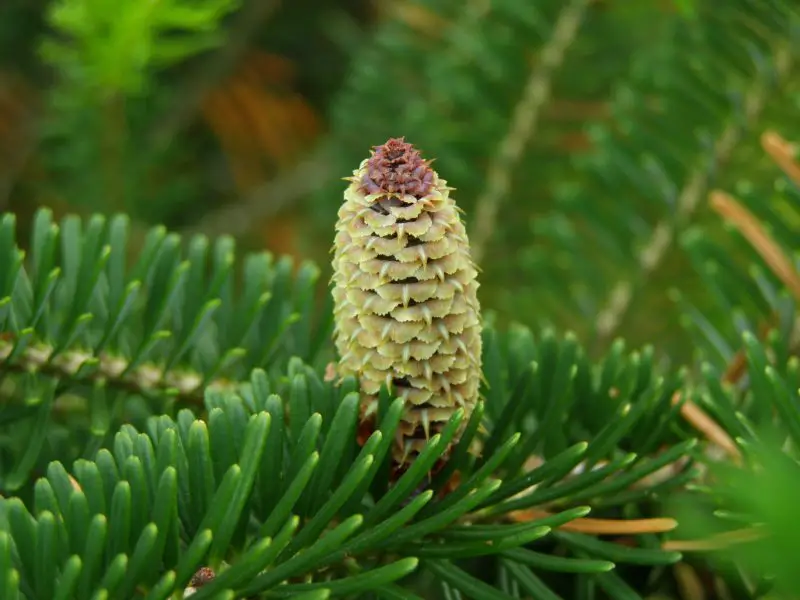
Fraser Fir is a compact, symmetrical evergreen highly prized as a Christmas tree for its pleasant fragrance, strong branches, and excellent needle retention. Native to the Appalachian Mountains, it has short, dark green needles with silvery undersides that provide a festive, lush appearance.
This tree is easily recognized by its upward-curving needles that are arranged in rows along the branches. It produces upright cones that disintegrate while still on the tree, releasing seeds. Its smooth gray bark and conical shape give it a refined, uniform look in the landscape.
Fraser Fir grows best in USDA zones 4 through 7 and prefers cool, moist, well-drained soils with full sun to partial shade. It requires consistent moisture and cooler temperatures, especially during summer. Avoid planting in areas with hot, dry conditions. Mulching and occasional deep watering are beneficial.
Norway Spruce (Picea abies)
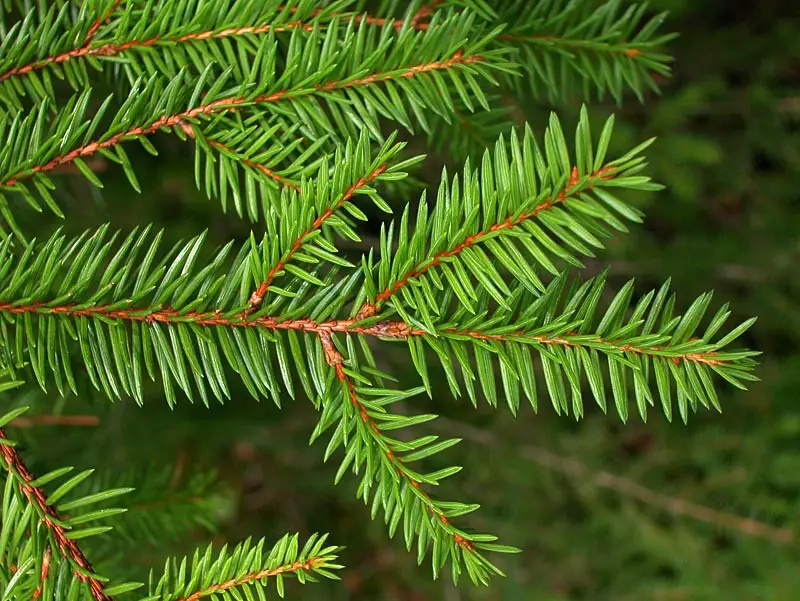
Norway Spruce is a fast-growing, stately evergreen tree known for its gracefully drooping branchlets and dark green needles. It’s often planted as a windbreak, privacy screen, or ornamental specimen in large landscapes and public parks.
You can identify Norway Spruce by its sharp, square needles that are about 1 inch long and its long, cylindrical cones that hang downward from branches. The tree develops a wide, pyramidal form with distinct weeping side branches as it matures, giving it an elegant appearance.
This species thrives in USDA zones 2 through 7 and prefers full sun and moist, well-drained soil. It adapts to a variety of soil types but performs best in cool climates. Once established, it is fairly drought-tolerant and requires minimal care aside from occasional mulching and watering during dry spells.
White Spruce (Picea glauca)
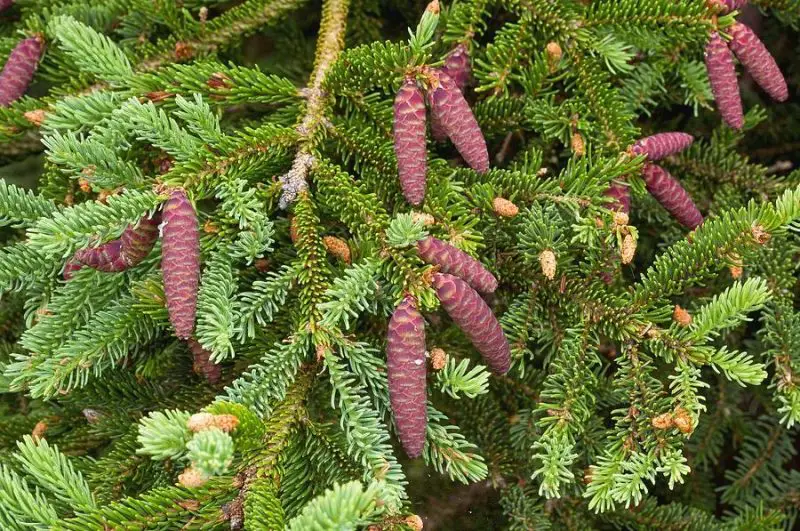
White Spruce is a resilient and attractive evergreen valued for its adaptability and tidy form. Native to northern North America, it has short, stiff, blue-green needles and a pyramidal shape that makes it ideal for windbreaks, screens, and ornamental use.
It can be identified by its dense foliage, which emits a slightly unpleasant odor when crushed—hence the nickname “cat spruce.” The needles are about ¾ inch long and are attached spirally around the branches. The tree produces slender, cylindrical cones and has a grayish, flaky bark.
White Spruce thrives in USDA zones 2 through 6 and grows well in full sun and well-drained, acidic to neutral soils. It tolerates cold, wind, and urban conditions better than many other conifers. To maintain its health, ensure it has space to grow and receives regular watering during dry conditions.
Deodar Cedar (Cedrus deodara)
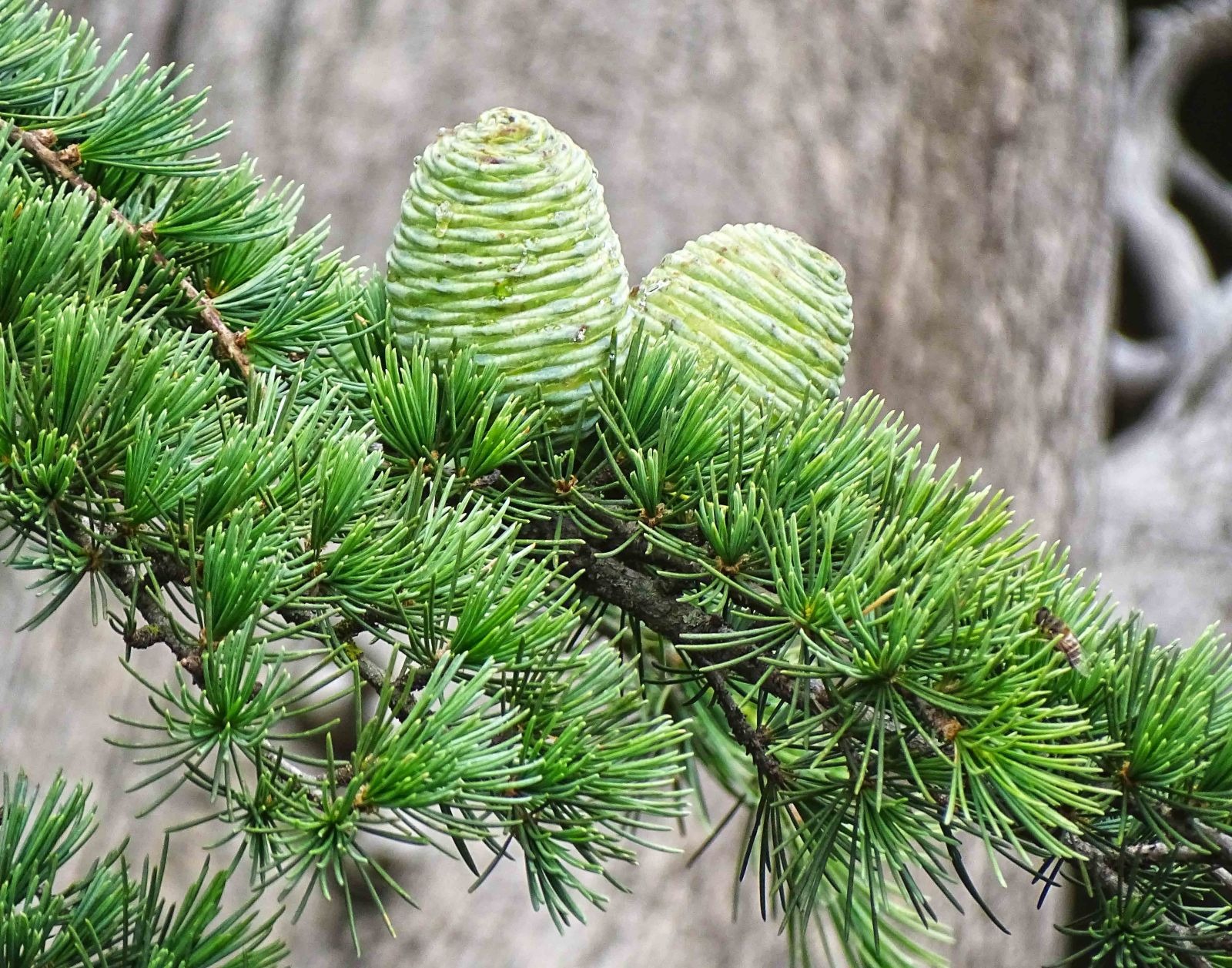
Deodar Cedar is a graceful, pyramid-shaped evergreen with soft, bluish-green needles and drooping branches that give it a weeping appearance. Native to the Himalayas, this tree brings an elegant silhouette to large gardens, parks, and estates. Its name means “timber of the gods,” reflecting its cultural and aesthetic value.
It is easily recognized by its long, thin needles that are grouped in clusters and its cones that sit upright on the branches. The tree can reach heights of 40 to 70 feet in cultivation and may spread widely if space allows. Its light gray bark becomes furrowed with age, adding to its visual interest.
Hardy in USDA zones 7 through 9, Deodar Cedar prefers full sun and well-drained, slightly acidic soil. It tolerates heat better than other true cedars and is moderately drought-tolerant once established. Avoid planting in poorly drained areas, and water deeply during extended dry periods.
Holly (Ilex aquifolium)

Holly is a classic broadleaf evergreen known for its glossy, spiny leaves and bright red berries, often associated with winter and holiday décor. Native to Europe, this tree or large shrub adds structure and color year-round and is often used for hedges, topiaries, and specimen planting.
It is identifiable by its dark green, leathery leaves with sharp points along the edges and its small white flowers that bloom in spring. Female plants produce vibrant berries when pollinated by a nearby male plant. The berries persist into winter, attracting birds and adding seasonal appeal.
Holly thrives in USDA zones 5 through 9 and prefers moist, well-drained soil in full sun to partial shade. It benefits from mulching and regular watering during dry spells, especially when newly planted. Prune in late winter or early spring to shape and remove any dead or damaged growth.
Live Oak (Quercus virginiana)
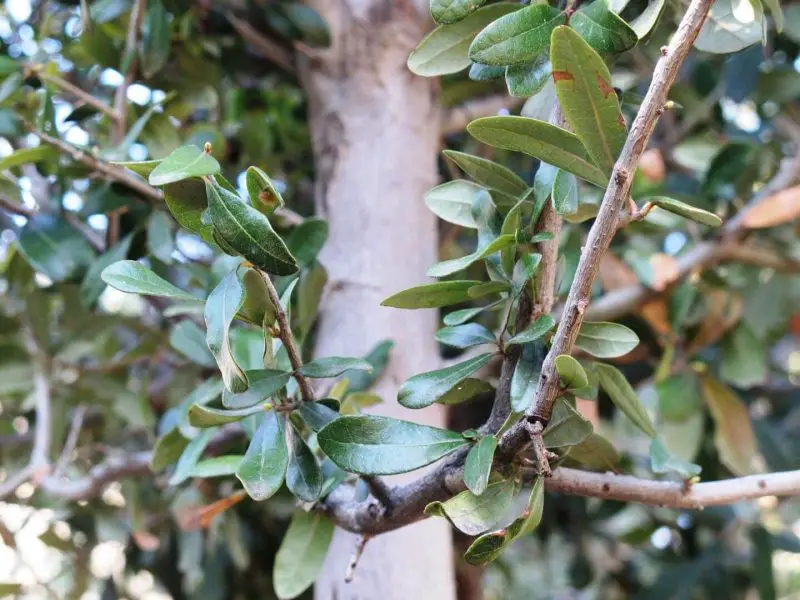
Live Oak is a sprawling, broad-canopied evergreen native to the southeastern United States. With its thick, leathery leaves and dramatically curved limbs, it creates iconic southern landscapes and provides deep shade in residential or park settings.
It can be identified by its dark green, glossy leaves that stay on the tree year-round and its rough, furrowed bark. Mature Live Oaks often develop wide, horizontal branches that may be draped with Spanish moss, enhancing their old-world charm. The tree produces small acorns that serve as food for wildlife.
Live Oak grows best in USDA zones 7 through 10 and prefers full sun and well-drained soils. It tolerates drought, salt, and wind, making it suitable for coastal environments. Minimal pruning is needed, but care should be taken not to damage roots during construction or landscaping.
Italian Cypress (Cupressus sempervirens)
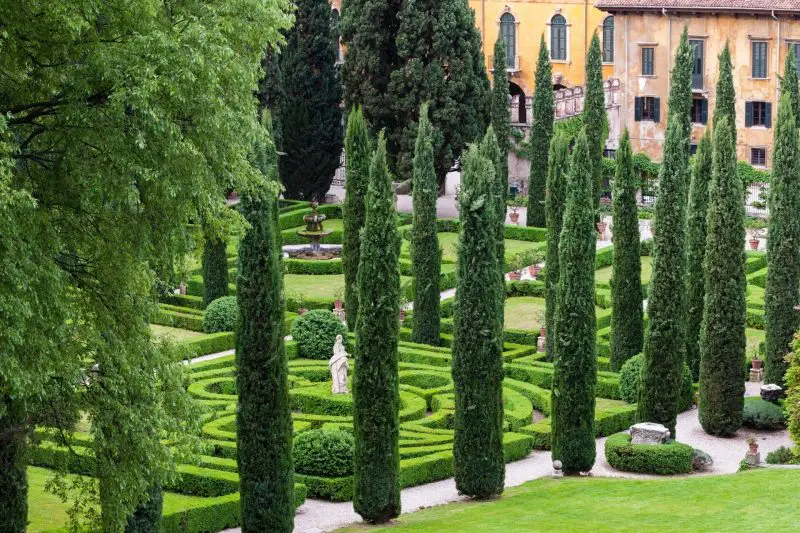
Italian Cypress is a tall, narrow evergreen with a columnar form that makes a dramatic architectural statement in formal landscapes. Native to the Mediterranean region, it is often planted in rows to frame driveways or as focal points in gardens.
It is characterized by its dense, dark green foliage arranged on upright, tightly packed branches. The tree produces small, round cones and typically grows 40 to 60 feet tall with a spread of only 4 to 5 feet. Its tidy silhouette requires little pruning and adds vertical contrast in landscape designs.
Italian Cypress thrives in USDA zones 7 through 11 and prefers full sun and well-drained soil. It is drought-tolerant and thrives in hot, dry climates. Avoid overwatering, and provide good air circulation to prevent fungal issues, especially in humid environments.
Yew (Taxus baccata)
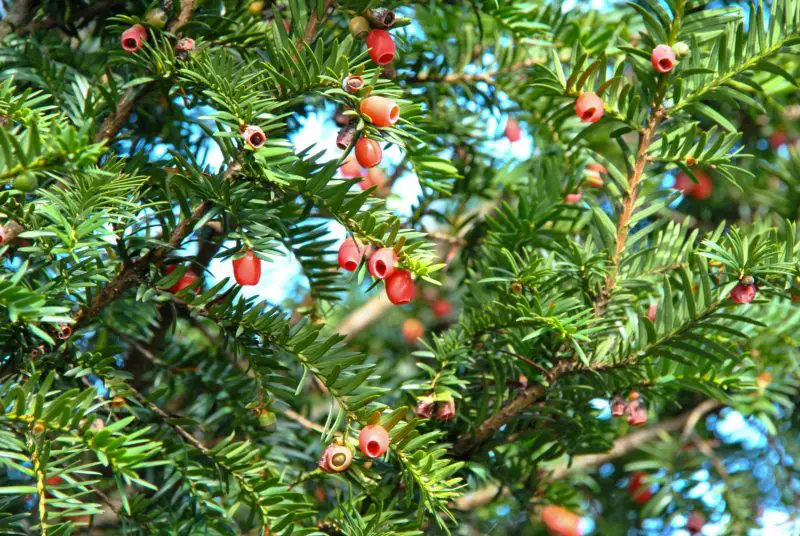
Yew is a slow-growing, long-lived evergreen with dark green, needle-like leaves and a dense growth habit. Native to Europe, western Asia, and northern Africa, it is often used for hedges, topiary, and foundation plantings due to its tolerance of pruning and shaping.
It can be recognized by its soft, flat needles that are arranged in two rows on either side of the stem. The female plants produce red, berry-like arils that are attractive but highly toxic if ingested. Its reddish-brown bark peels in thin flakes, adding subtle texture to its appearance.
Hardy in USDA zones 5 through 7, Yew prefers partial shade to full sun and well-drained soil. It dislikes wet conditions and may suffer root rot if planted in soggy soil. Regular pruning helps maintain form, and it responds well to rejuvenation if it becomes overgrown.
Ponderosa Pine (Pinus ponderosa)
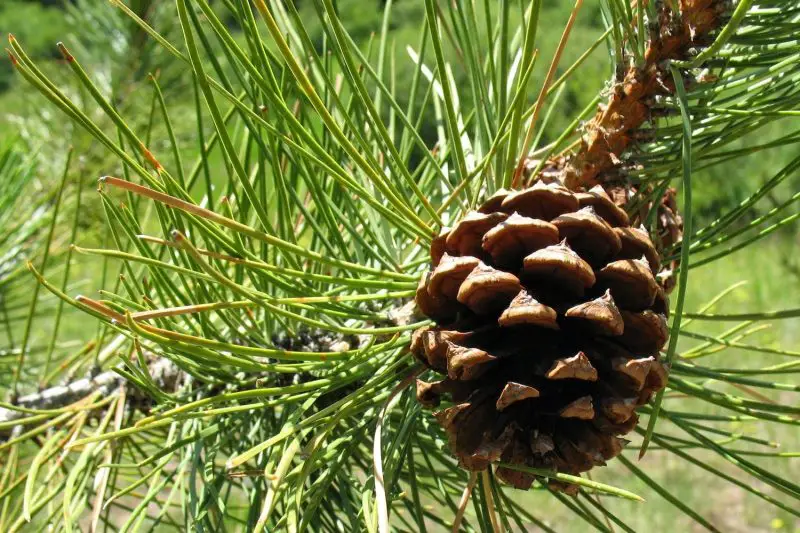
Ponderosa Pine is a towering evergreen native to the western United States, known for its long needles and orange-brown, puzzle-piece bark. It grows rapidly and is commonly used for reforestation, windbreaks, and ornamental planting in large open spaces.
This tree can be identified by its needles, which are grouped in bundles of three and can reach up to 10 inches in length. The bark of mature trees becomes thick and deeply furrowed, emitting a sweet, vanilla-like scent when warmed by the sun. Its cones are egg-shaped and prickly to the touch.
Ponderosa Pine grows best in USDA zones 3 through 7 and thrives in full sun and well-drained, sandy or rocky soils. It is highly drought-tolerant once established and prefers dry climates. Young trees need deep watering during prolonged dry periods, but established trees require minimal maintenance.
Rhododendron (Rhododendron spp.)
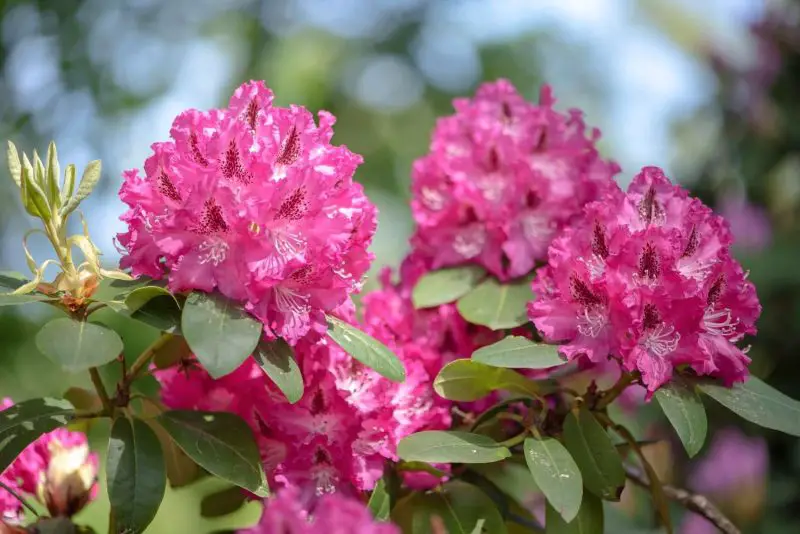
Rhododendrons are broadleaf evergreens known for their large, leathery leaves and spectacular clusters of spring flowers. Native to various parts of Asia, Europe, and North America, they bring lush greenery and vibrant color to gardens throughout the year. Their showy blooms come in a wide range of colors including pink, purple, white, and red.
These plants are easily recognized by their thick, dark green leaves arranged in a whorled pattern and their bell-shaped flowers that bloom in clusters. Most rhododendrons have a rounded or mounded growth habit, making them excellent choices for woodland borders or foundation plantings.
Hardy in USDA zones 4 through 8 depending on species, Rhododendrons prefer partial shade and acidic, well-drained soil rich in organic matter. They benefit from consistent moisture and mulching, but dislike soggy roots. Prune lightly after flowering to shape and remove faded blooms.
Camellia (Camellia japonica)
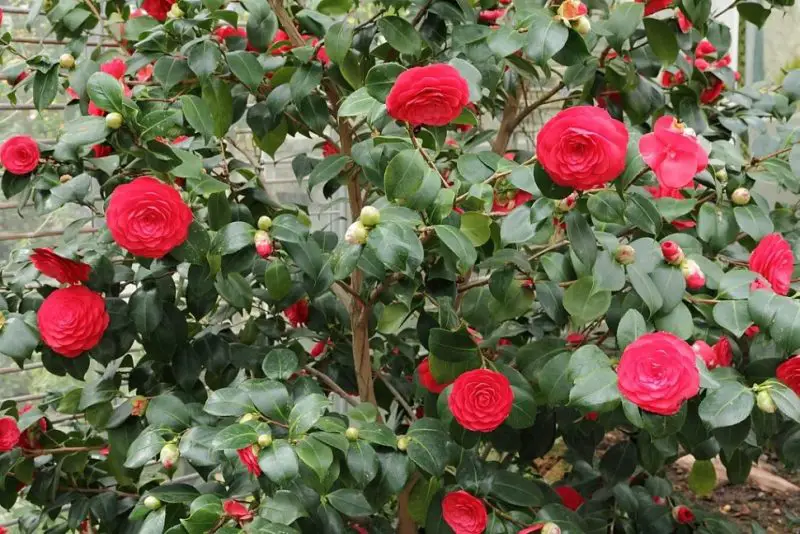
Camellia is a striking evergreen shrub admired for its glossy, deep green leaves and rose-like flowers that bloom from late fall through early spring. Native to East Asia, Camellia brings elegance and seasonal color to shade gardens and woodland borders.
It can be identified by its leathery, serrated leaves and its large, symmetrical flowers, which come in shades of pink, red, and white. The blooms often appear when few other plants are flowering, adding winter interest. Camellias grow in an upright, rounded form and may reach 6 to 12 feet tall.
Camellia japonica thrives in USDA zones 7 through 9 and prefers dappled shade and acidic, well-drained soil. Keep the soil consistently moist but not waterlogged. Mulch to keep roots cool, and avoid heavy pruning—only remove dead or awkward branches after blooming.
Photinia (Photinia × fraseri)
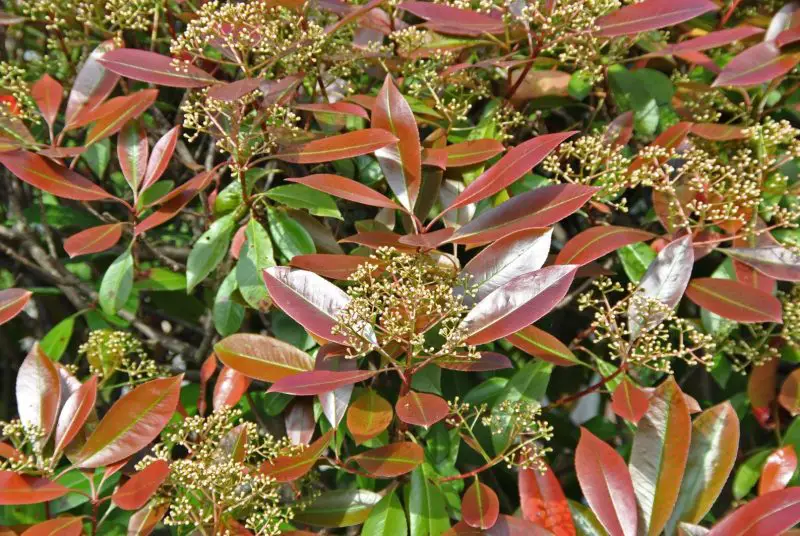
Photinia is a fast-growing evergreen shrub prized for its vibrant red new foliage that matures to dark green. A hybrid commonly known as Red Tip Photinia, it is widely used for hedges and privacy screens due to its dense growth and colorful appearance.
It is recognized by its oval, leathery leaves and small clusters of white flowers in spring. The red flush of new leaves provides seasonal interest, though some gardeners remove the flowers to reduce mess. It can grow up to 10 to 15 feet tall and is tolerant of shaping.
Photinia grows well in USDA zones 7 through 9 and prefers full sun to partial shade and fertile, well-drained soil. Prune regularly to encourage new red growth and improve air circulation, as it can be susceptible to leaf spot in humid conditions. Avoid overhead watering to reduce disease risk.
Chinese Juniper (Juniperus chinensis)

Chinese Juniper is a versatile evergreen tree or shrub known for its dense foliage, rugged form, and adaptability to different landscape uses. Native to China and Mongolia, it is available in upright, pyramidal, or spreading varieties suited for hedges, bonsai, or specimen planting.
It is distinguished by its sharp, scale-like or needle-like foliage that ranges from green to blue-green depending on the cultivar. This juniper often bears small, round, bluish berries that are attractive to birds. Mature plants have a rough, grayish bark and dense branching.
Hardy in USDA zones 4 through 9, Chinese Juniper prefers full sun and well-drained soil. It tolerates drought, heat, and urban pollution, making it ideal for low-maintenance landscapes. Little pruning is required, but shaping can be done in late winter or early spring.
Laurel Bay / Bay Laurel (Laurus nobilis)
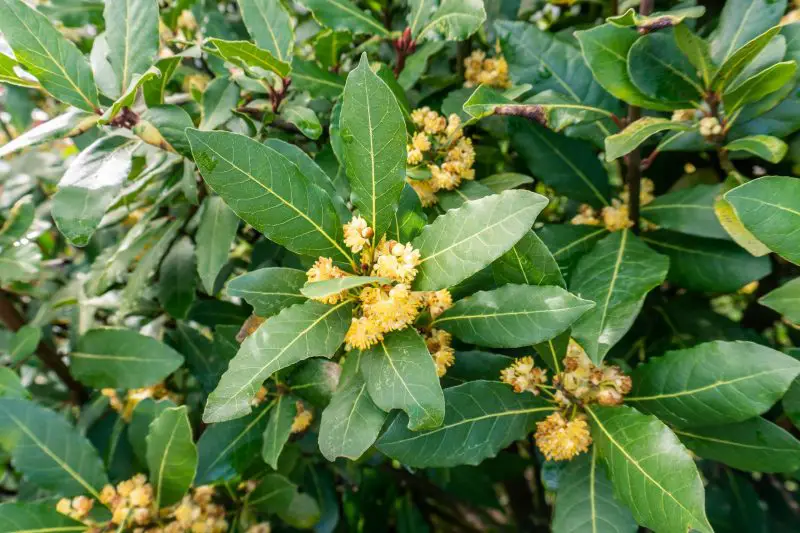
Bay Laurel is a Mediterranean evergreen shrub or small tree known for its aromatic leaves, which are used as a culinary herb. Its dark green, lance-shaped foliage and tidy, upright growth habit make it an attractive and practical addition to ornamental or herb gardens.
It is easily recognized by its smooth, glossy leaves and clusters of small yellowish flowers in spring. Bay Laurel can be pruned into formal shapes or left to grow naturally. The leaves are often harvested and dried for use in soups, stews, and sauces.
Bay Laurel grows well in USDA zones 8 through 10 and prefers full sun to partial shade and well-drained soil. It is drought-tolerant once established but benefits from regular watering in hot, dry climates. In colder zones, it can be grown in containers and brought indoors during winter.
Scots Pine (Pinus sylvestris)
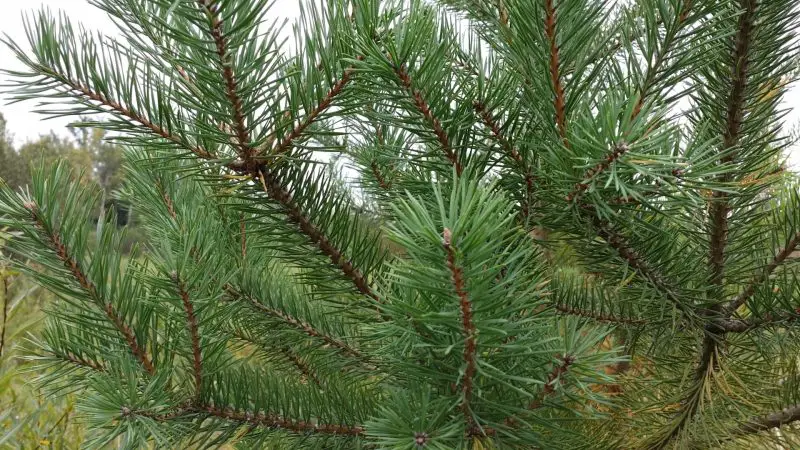
Scots Pine is a hardy, fast-growing conifer native to Europe and Asia, known for its long needles and distinctive orange-brown bark on the upper trunk. It is commonly used in reforestation, windbreaks, and as a Christmas tree in some regions.
It can be identified by its paired needles that are about 2 to 4 inches long and slightly twisted. Mature trees develop a broad, open crown and shedding bark that reveals colorful, flaky layers. Cones are small, brown, and egg-shaped, and the tree emits a pleasant pine fragrance.
Scots Pine is hardy in USDA zones 2 through 7 and grows best in full sun and sandy, well-drained soils. It is drought-tolerant and low-maintenance once established. Avoid heavy clay soils and prune only to remove dead or damaged branches in late winter.
Arizona Cypress (Cupressus arizonica)
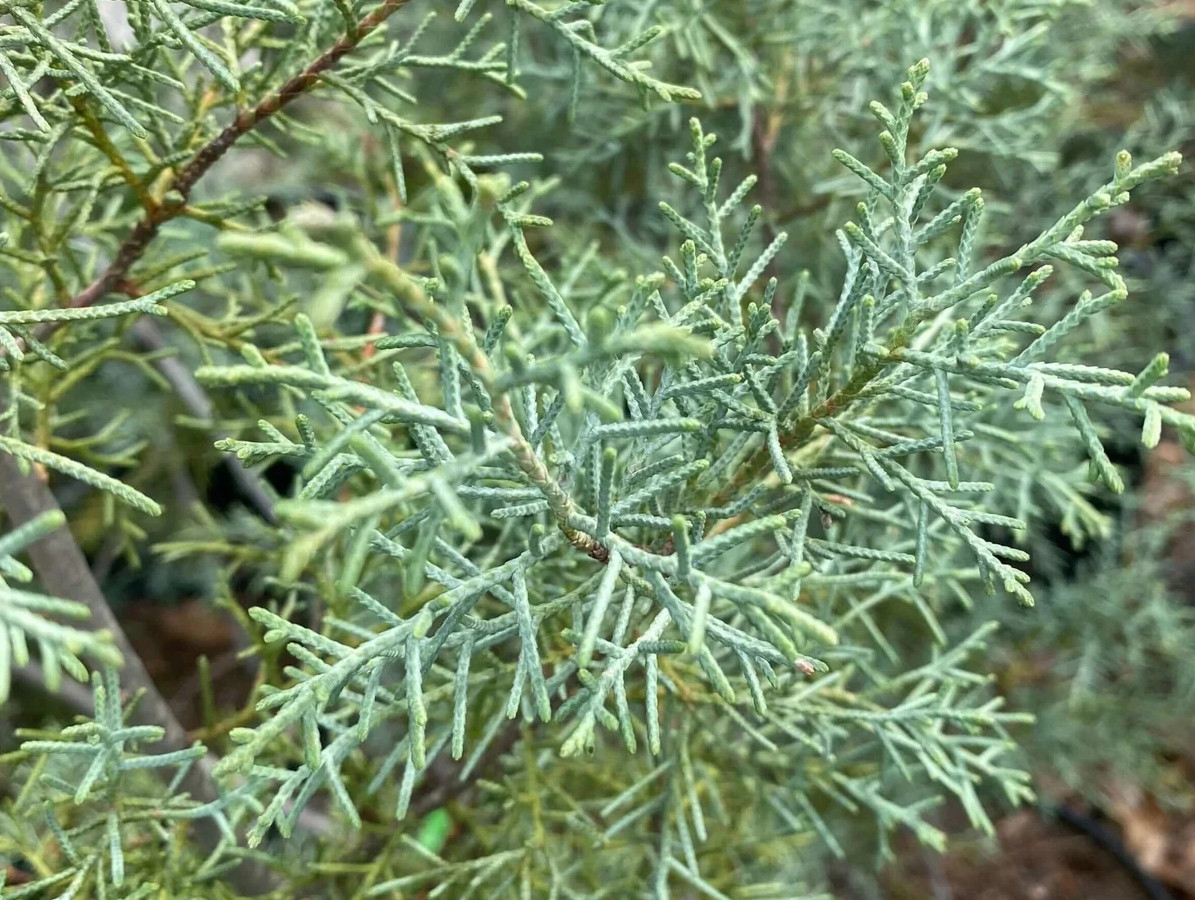
Arizona Cypress is a fast-growing evergreen tree native to the southwestern United States and northern Mexico. It is appreciated for its fine, feathery foliage and its ability to thrive in hot, dry conditions, making it ideal for xeriscaping and windbreaks. The tree develops a narrow, conical shape and matures gracefully into a more open form.
Its foliage varies in color from bluish-gray to silvery green, and the needles are scale-like and aromatic when crushed. The bark is smooth and reddish-brown, shedding in thin strips. Arizona Cypress produces small, round cones that mature over two years and can persist on the tree.
Hardy in USDA zones 7 through 9, this tree prefers full sun and well-drained soil. It is extremely drought-tolerant once established and requires little maintenance. Water deeply during prolonged dry spells and avoid planting in poorly drained or humid areas to prevent root rot or fungal issues.
Pittosporum (Pittosporum tobira)

Pittosporum is a compact, evergreen shrub often used for hedges, borders, and foundation plantings. Native to Japan and China, this plant is popular in southern landscapes due to its tolerance for heat, salt, and pruning. It features a dense, rounded form with waxy, dark green leaves.
The leaves are oval, leathery, and often have wavy margins. In spring, Pittosporum produces small, creamy-white flowers that are intensely fragrant, resembling orange blossoms. It is commonly shaped into tidy hedges or grown as a small ornamental tree in warmer climates.
Suitable for USDA zones 8 through 11, Pittosporum thrives in full sun to partial shade and prefers well-drained, fertile soil. It tolerates drought once established but grows best with occasional deep watering. Prune after flowering to maintain shape and encourage dense growth.
Privet (Ligustrum spp.)
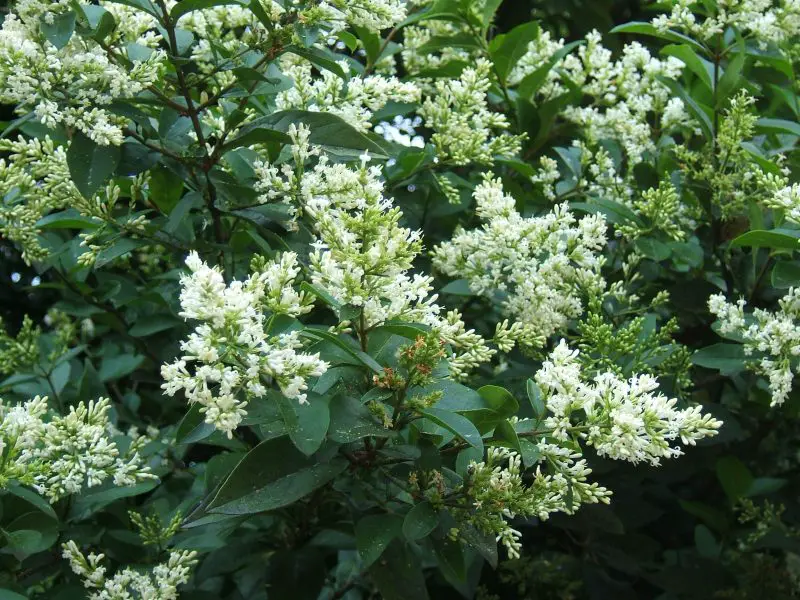
Privet is a fast-growing, semi-evergreen to evergreen shrub often used for formal hedges, screens, or topiary. Native to Europe and Asia, it’s known for its quick adaptability, dense branching, and ability to withstand heavy pruning, making it ideal for creating living fences.
The foliage consists of small, oval leaves that are dark green and glossy. In late spring to early summer, privet produces upright clusters of small white flowers that are mildly fragrant, followed by black berries that attract birds. Left untrimmed, it can grow into a small tree.
Privet grows in USDA zones 5 through 9 depending on species and thrives in full sun to partial shade. It prefers well-drained soil but tolerates a variety of conditions, including urban pollution. Trim regularly during the growing season to maintain shape and prevent flowering if berries are undesirable.
Tea Olive (Osmanthus fragrans)
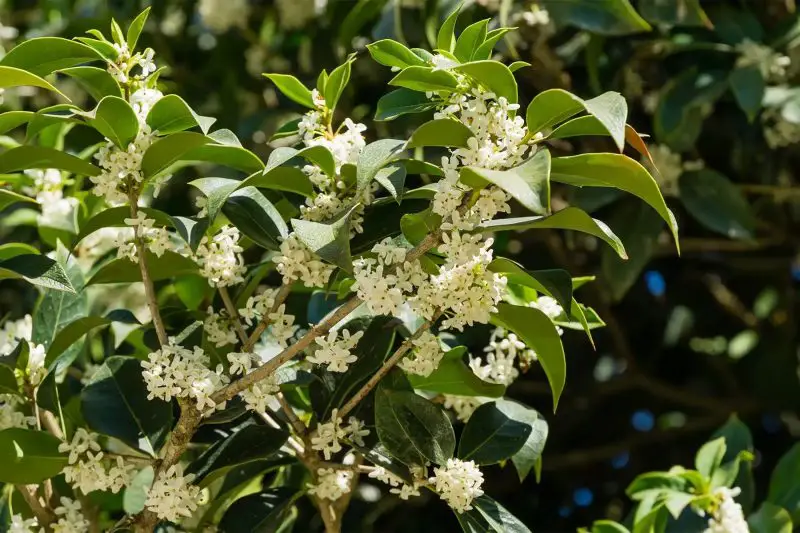
Tea Olive is a beloved evergreen shrub or small tree celebrated for its intensely fragrant flowers. Native to Asia, it is widely grown in southern gardens for its sweet, jasmine-like scent and glossy foliage. This plant can serve as a specimen, hedge, or accent near patios and entryways.
It has leathery, oblong leaves with finely serrated edges and produces tiny, white to orange flowers in fall and spring. Though small and subtle in appearance, the blossoms emit a powerful aroma that can perfume an entire garden. The plant grows in a dense, upright form and can be clipped into formal shapes.
Tea Olive thrives in USDA zones 7 through 10, performing best in full sun to partial shade and rich, well-drained soil. It is moderately drought-tolerant once established but benefits from consistent watering during dry periods. Prune after flowering to maintain size and encourage new blooms.
Atlas Cedar (Cedrus atlantica)
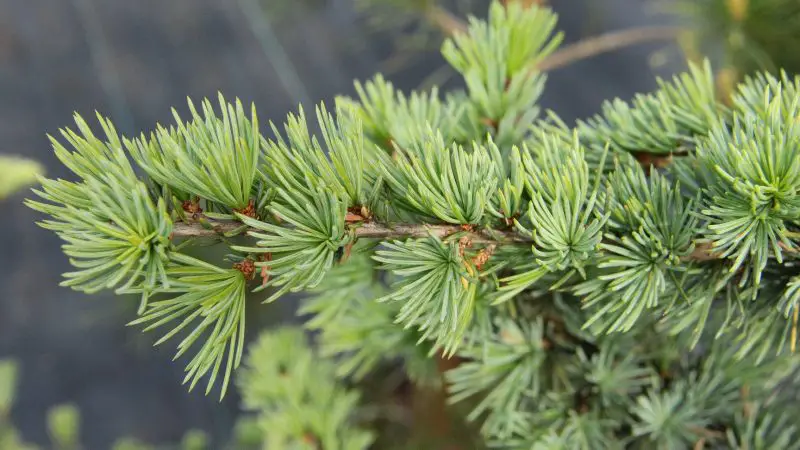
Atlas Cedar is a majestic evergreen conifer native to the Atlas Mountains of Morocco and Algeria. It is appreciated for its elegant, horizontal branching and striking blue-green or silvery-blue needle clusters. This slow-growing tree is often planted as a specimen in large landscapes or parks.
Its needles are arranged in rosettes on short shoots, and the tree forms a broad, pyramidal crown with age. Older trees develop a distinctive, sculptural form with layered branches. The cones are barrel-shaped and sit upright on the branches, typical of true cedars.
Hardy in USDA zones 6 through 9, Atlas Cedar prefers full sun and well-drained soil. It is drought-tolerant once established and requires little pruning. Avoid overly wet or compacted soils. Space trees well apart to allow for their mature size and architectural beauty.
Cedar of Lebanon (Cedrus libani)
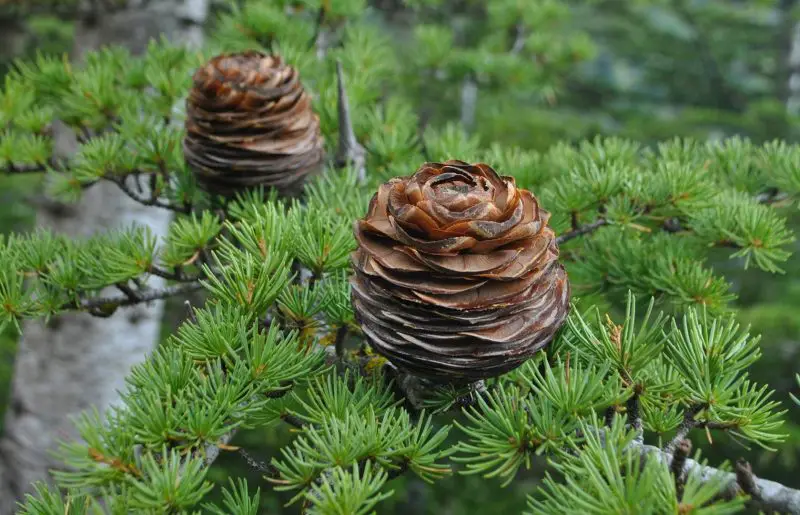
Cedar of Lebanon is a slow-growing, majestic evergreen tree native to the Eastern Mediterranean. Revered for centuries in art and architecture, it features a flat-topped crown and strong, spreading branches. This iconic tree is ideal for expansive landscapes and historical gardens.
It bears short, dark green needles arranged in dense clusters along horizontal branches. With age, the tree becomes broad and massive, creating a dramatic silhouette. The cones are upright and slowly disintegrate on the tree to release seeds, adding to its stately appearance.
Thriving in USDA zones 6 through 9, Cedar of Lebanon prefers full sun and well-drained, slightly alkaline soil. It tolerates drought once established and does not require pruning unless needed to remove dead wood. Provide ample space and patience to let this tree reach its full grandeur.
Japanese Black Pine (Pinus thunbergii)
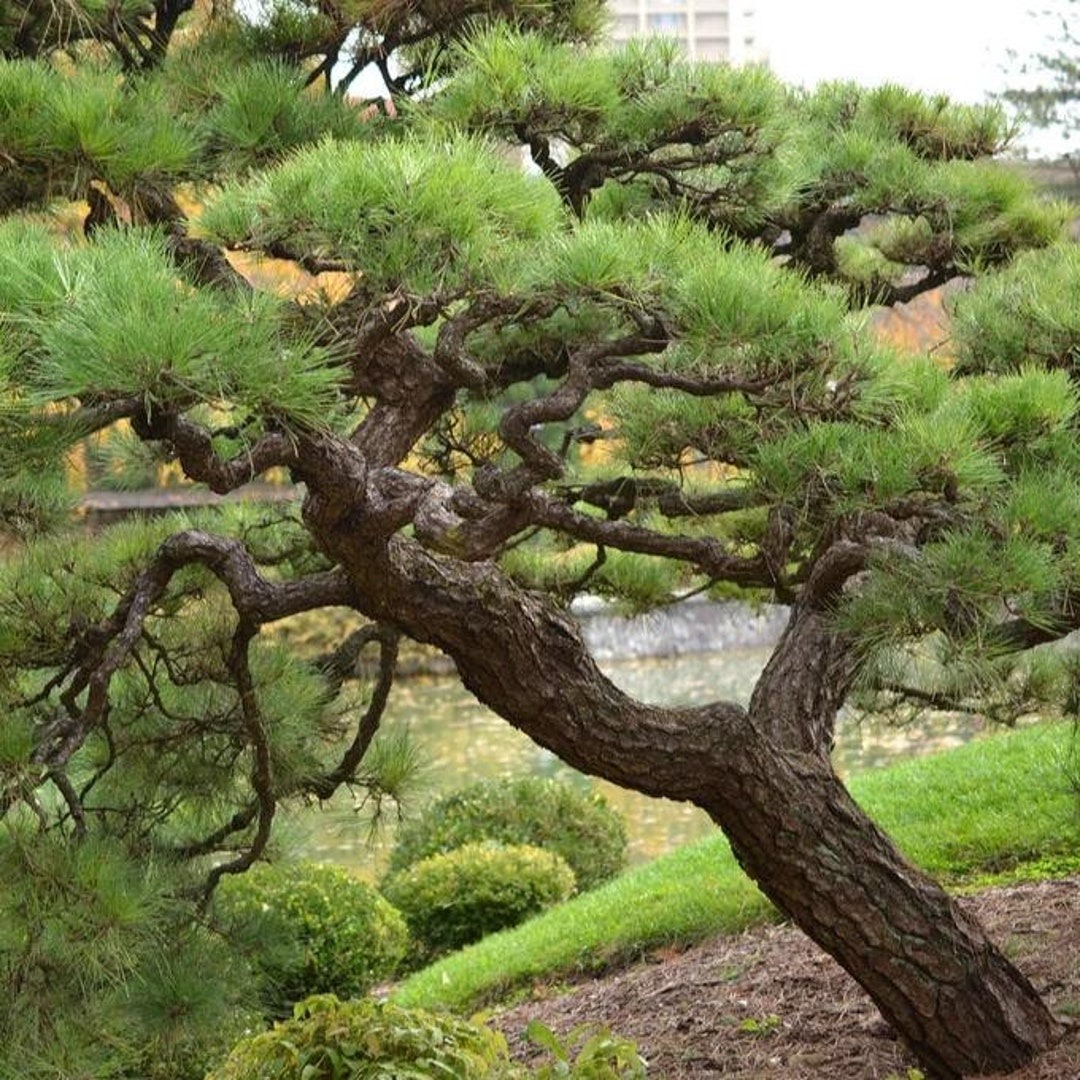
Japanese Black Pine is a striking evergreen conifer native to coastal regions of Japan and South Korea. Known for its rugged, picturesque form and resistance to salt spray, it is a favorite in seaside landscapes and traditional Japanese gardens. The tree typically has a flat-topped canopy and irregular branching that becomes more pronounced with age.
Its needles are dark green, stiff, and grow in pairs, creating a dense, textured appearance. The bark becomes deeply fissured and black-gray as it matures, adding ornamental interest year-round. Small cones appear in clusters and mature to a light brown color, contributing to the tree’s visual appeal.
Hardy in USDA zones 5 through 8, Japanese Black Pine thrives in full sun and well-drained, sandy soils. It is highly drought- and salt-tolerant once established. Prune selectively to maintain form and remove interior growth for airflow. It is commonly used as a specimen tree or in bonsai cultivation due to its striking silhouette.
Japanese Cedar (Cryptomeria japonica)
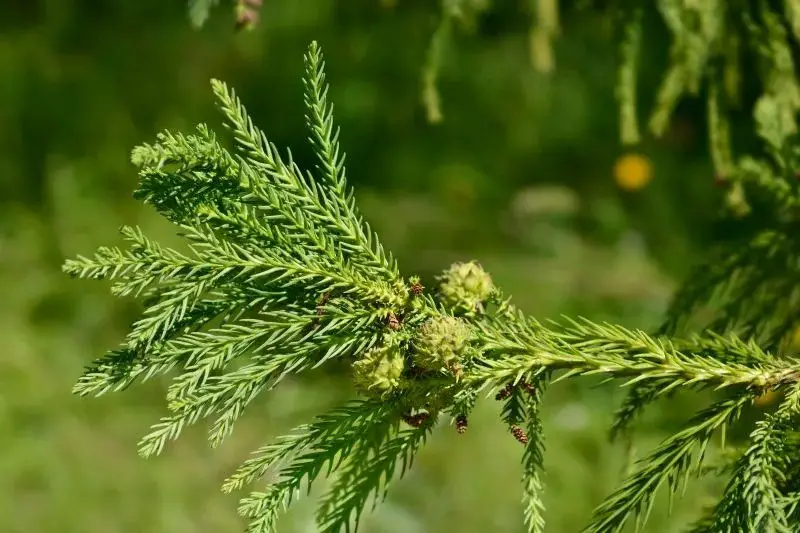
Japanese Cedar is a graceful, pyramidal evergreen tree native to Japan and China. It is prized for its soft, feathery foliage and attractive reddish-brown bark that peels in strips. The tree grows quickly and can reach impressive heights, making it a common choice for large landscapes or privacy screens.
The leaves are slender, needle-like, and arranged in spirals along the shoots, giving a fine-textured look. They are bright green in summer and may turn bronze in winter, especially in colder zones. The small, round cones are about an inch wide and appear in clusters on the branches.
Hardy in USDA zones 6 through 9, Japanese Cedar prefers full sun to partial shade and moist, slightly acidic soil. It does well in areas with high humidity and regular rainfall. Protect young trees from drying winds and mulch the base to retain moisture. Prune lightly to maintain shape and remove dead growth.
Southern Yew (Podocarpus macrophyllus)
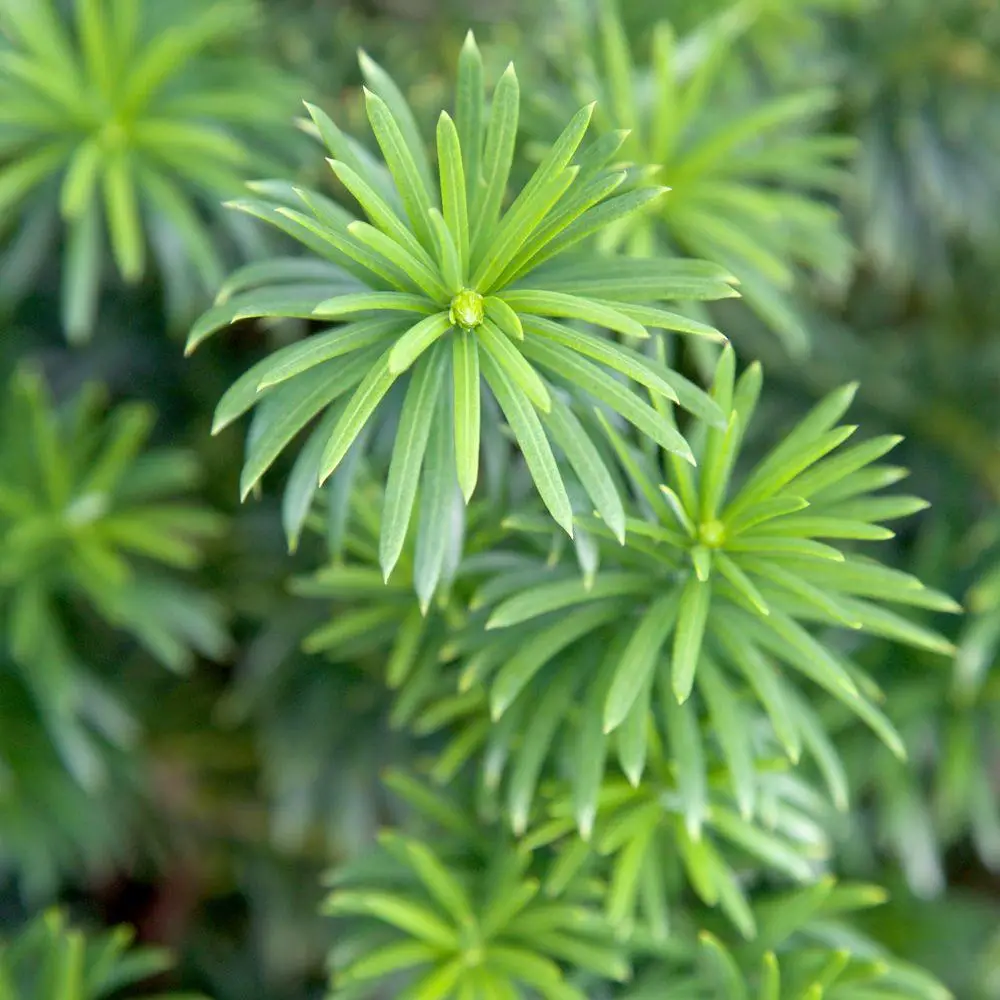
Southern Yew, also known as Japanese Yew or Buddhist Pine, is a versatile evergreen shrub or tree native to China and Japan. It has a neat, upright growth habit and is often used in hedges, foundation plantings, or shaped into topiary forms in southern landscapes.
Its dark green leaves are narrow, leathery, and resemble needles, though they are softer and more flexible than those of true yews. Southern Yew bears small, fleshy, bluish-purple fruits that are technically cones, though they resemble berries and are often eaten by birds.
Suitable for USDA zones 7 through 10, Southern Yew grows best in full sun to partial shade and moist, well-drained soil. It tolerates urban conditions, pruning, and drought once established. Regular shearing will encourage denser foliage, making it excellent for formal hedges and screens.
Monkey Puzzle Tree (Araucaria araucana)
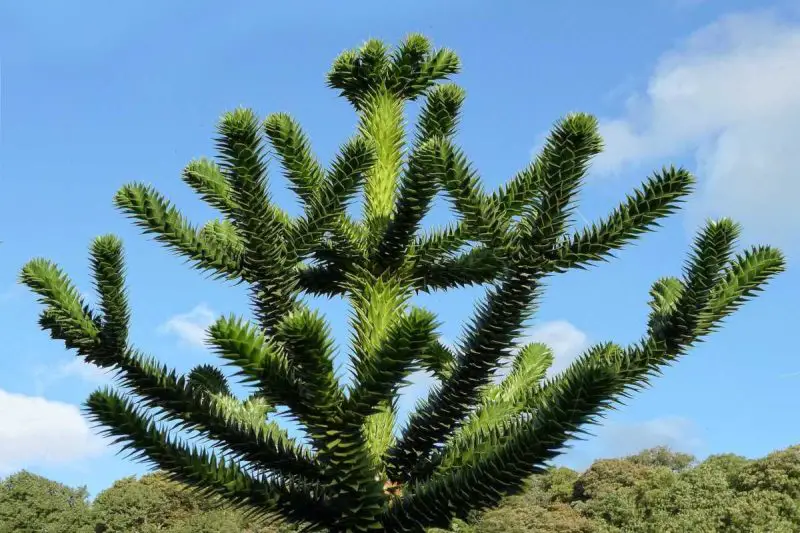
The Monkey Puzzle Tree is a unique and ancient evergreen conifer native to the Andes Mountains of Chile and Argentina. Its striking appearance, with stiff, spiraled leaves and sharply angular branches, makes it a bold specimen tree in gardens and parks.
Its triangular, leathery leaves are arranged in whorls and are sharp to the touch, forming dense coverage along the thick, upward-curving branches. The tree eventually develops a tall, narrow profile with a strong central trunk and an umbrella-shaped crown. It produces large, rounded cones on mature specimens.
Hardy in USDA zones 7 through 10, Monkey Puzzle prefers full sun and well-drained, acidic soil. It dislikes high humidity and soggy conditions, so proper site selection is essential. Water regularly when young, but once established, it becomes fairly drought-tolerant. Plant as a focal point where its unusual texture can be appreciated from a distance.
Carolina Cherry Laurel (Prunus caroliniana)
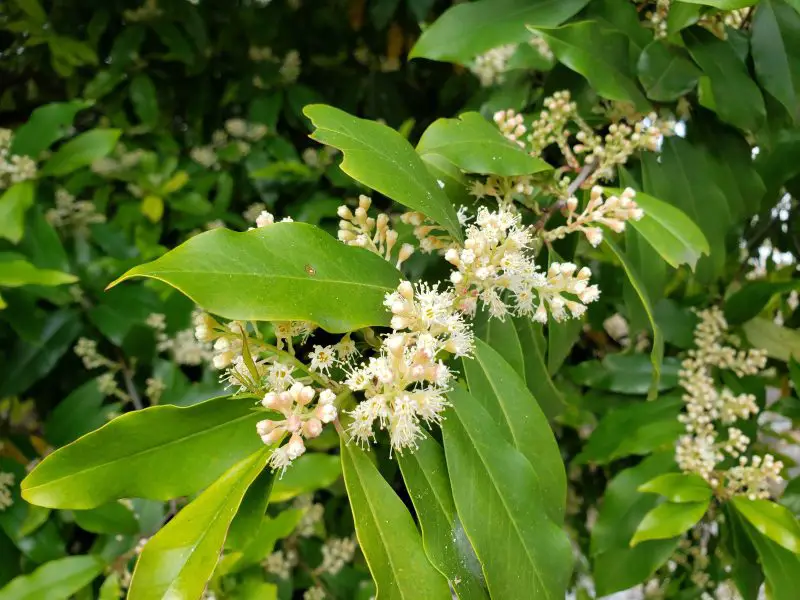
Carolina Cherry Laurel is a fast-growing, evergreen shrub or small tree native to the southeastern United States. It is widely used as a privacy hedge, windbreak, or specimen plant thanks to its dense foliage and adaptability. It forms a naturally rounded shape with upright growth.
The glossy, dark green leaves are oval and emit a strong almond-like scent when crushed. In spring, the plant produces fragrant white flower spikes followed by small, black cherries that attract birds. While beautiful, the leaves and berries contain compounds that are toxic if ingested in large quantities.
Thriving in USDA zones 7 through 10, Carolina Cherry Laurel tolerates full sun to partial shade and a range of soils, though it prefers moist, well-drained conditions. Prune regularly to maintain shape and prevent legginess. This shrub is low-maintenance, drought-tolerant, and ideal for hedging or screening.
Olive Tree (Olea europaea)
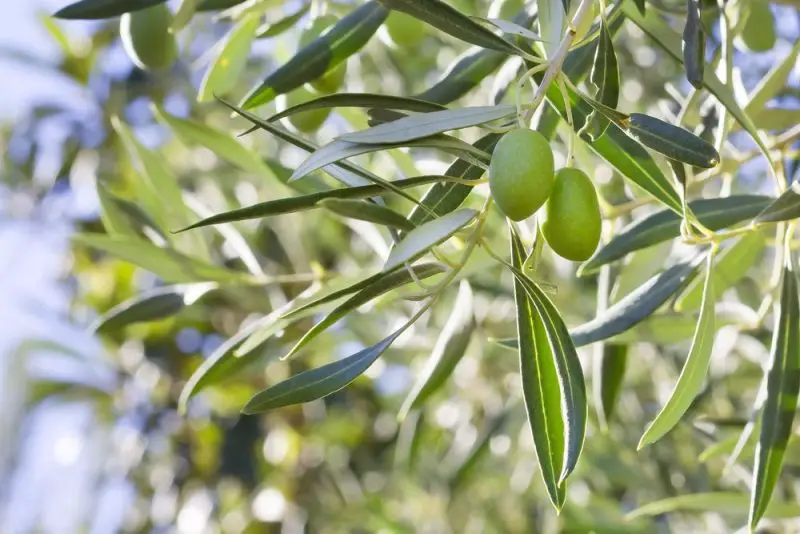
The Olive Tree is a long-lived evergreen native to the Mediterranean region, valued both for its silvery-green foliage and its edible fruit. It has a gnarled, picturesque trunk that becomes more twisted with age, making it highly ornamental in dry-climate landscapes.
Its narrow, lance-shaped leaves are green on top and silvery underneath, giving the tree a luminous appearance. In late spring, it bears small, creamy-white flowers followed by green olives that ripen to black. The fruit is harvested for oil or brining, depending on the variety and region.
Hardy in USDA zones 8 through 10, Olive Trees require full sun and well-drained, alkaline to neutral soil. They are highly drought-tolerant and thrive in hot, dry climates. Avoid overwatering, and prune to maintain an open structure and improve air circulation. In colder areas, they may be grown in containers and brought indoors during winter.
Sugar Pine (Pinus lambertiana)
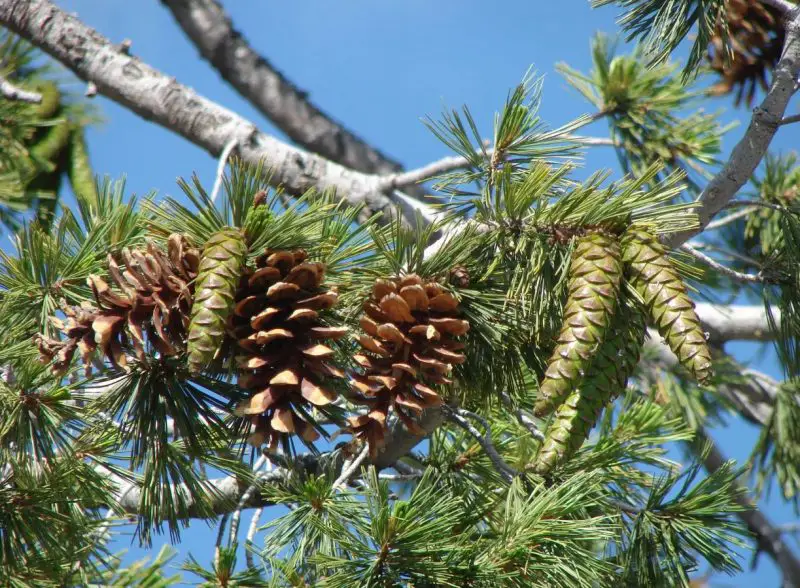
The Sugar Pine is one of the tallest and most majestic pine species, native to the mountainous regions of western North America. Known for its long, soft needles and large cones, this tree can reach towering heights of up to 200 feet in ideal conditions, making it a standout specimen in forests and landscapes.
Its needles are slender, bluish-green, and grow in bundles of five, creating a soft, feathery appearance. The cones of the Sugar Pine are the longest of any pine species, sometimes reaching over a foot in length. The bark is thick and deeply furrowed, providing a rugged, textured look.
Hardy in USDA zones 6 through 8, Sugar Pines prefer well-drained soils and full sunlight. They grow best in slightly acidic to neutral soil and are often used in timber production for their high-quality wood. To care for Sugar Pine, provide plenty of space for its large growth habit and ensure it gets adequate water, especially in dry spells.
Red Pine (Pinus resinosa)
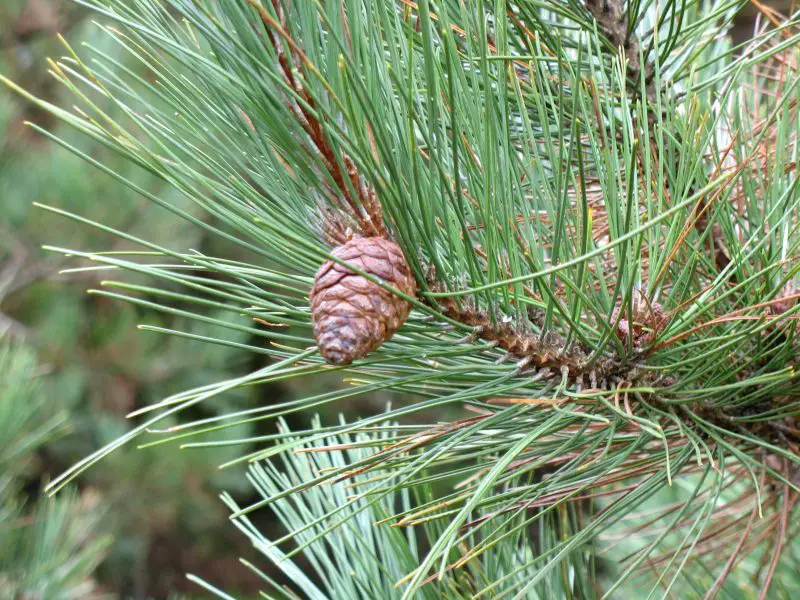
The Red Pine, also known as Norway Pine, is a tall, straight conifer native to the northeastern United States and Canada. It is prized for its reddish-brown bark, which gives the tree a distinctive appearance, especially as it matures. Red Pines are commonly found in forests and woodlands.
The tree has long, slender, dark green needles that grow in pairs. The bark on older trees becomes thick and reddish-brown, with deep furrows and scaly patches. Red Pines produce small cones that are about 2-3 inches long, which mature to a light brown color.
Hardy in USDA zones 3 through 7, Red Pines thrive in well-drained, acidic soils and full sun. They are relatively drought-tolerant once established but do best with regular watering. The Red Pine is often used for timber production and reforestation projects, as it grows quickly and provides valuable wood for various applications.
Eastern Hemlock (Tsuga canadensis)
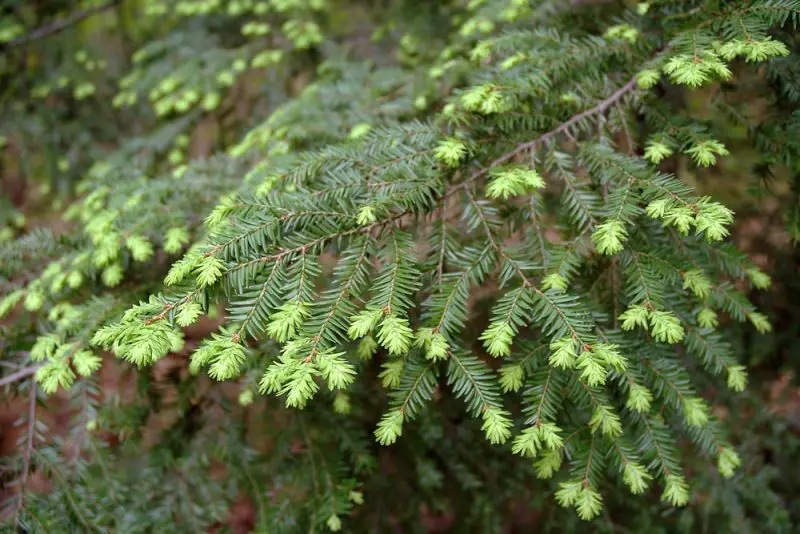
The Eastern Hemlock is a graceful evergreen tree native to the eastern United States. With its elegant, drooping branches and soft, feathery foliage, it is a popular choice for landscaping and as an ornamental tree. It thrives in shaded or partially shaded environments, making it well-suited for woodland gardens.
Its dark green needles are short, narrow, and flattened, with a distinct white line on the undersides. The tree produces small cones, typically about 1 inch long, which mature to a light brown color. The bark is grayish-brown with deep fissures and a rough texture.
Hardy in USDA zones 3 through 7, Eastern Hemlock prefers moist, well-drained soils and partial shade. It is an ideal tree for shaded gardens or as an understory tree in forested areas. Protect the tree from strong winds, as its drooping branches can be susceptible to damage. Hemlocks benefit from regular watering, especially in dry conditions.
Western Hemlock (Tsuga heterophylla)
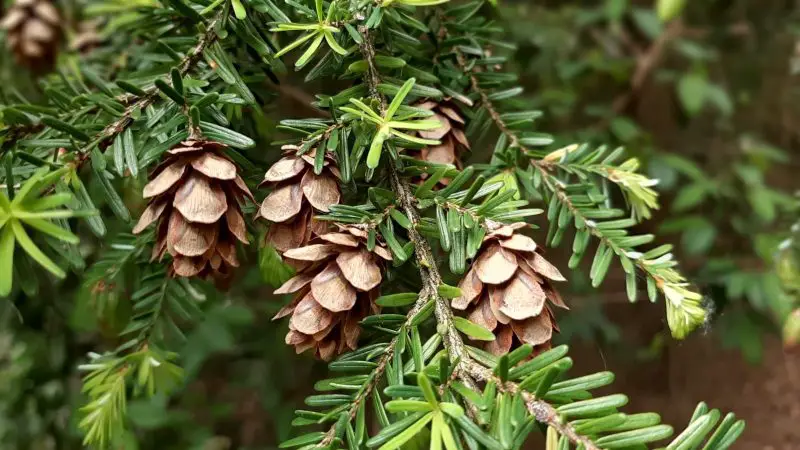
The Western Hemlock is the state tree of Washington and is native to the Pacific Northwest. It is known for its elegant, conical shape and the drooping, soft texture of its evergreen needles. Often found in cool, moist forests, it makes a beautiful addition to any landscape.
The needles of the Western Hemlock are glossy green on top with a silvery underside, and they are arranged in a flattened plane. Its small cones, around 1 inch in length, appear in the spring and turn a light brown as they mature. The bark is thin, light brown, and slightly scaly.
Western Hemlock is hardy in USDA zones 5 through 7 and grows best in shaded areas with moist, well-drained soil. It thrives in areas with high rainfall and is commonly used in forestry and timber industries. For proper care, ensure consistent moisture and avoid planting in areas with excessive heat or drought.
Balsam Fir (Abies balsamea)
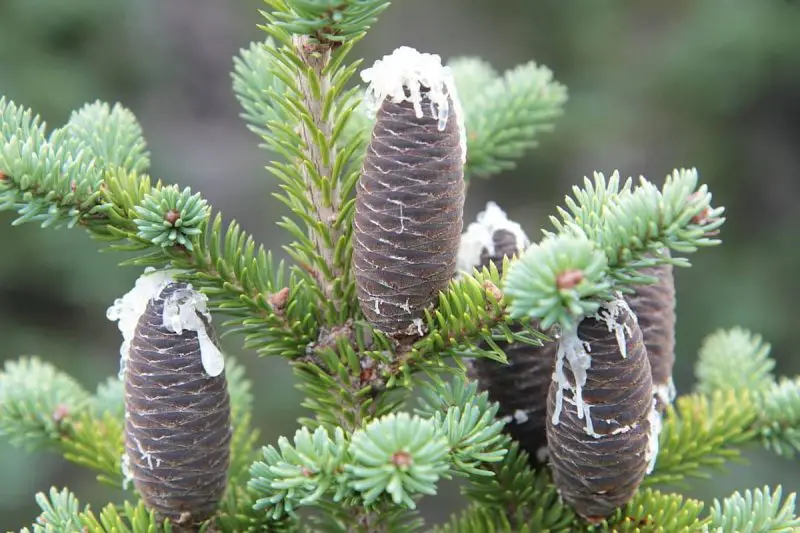
Balsam Fir is a fragrant evergreen tree native to North America, often found in the colder regions of Canada and the northeastern United States. It is well-known for its aromatic resin and soft, dense foliage, making it a popular choice for holiday wreaths and Christmas trees.
The tree has dark green, flat needles with a silvery underside, giving it a soft and attractive texture. The cones of Balsam Fir are cylindrical, about 3-5 inches long, and remain attached to the tree until they disintegrate. The bark is smooth and grayish, with resin blisters that give off a distinct scent.
Hardy in USDA zones 3 through 5, Balsam Fir prefers cold, humid climates with well-drained, acidic soils. It does well in full sun to partial shade and requires regular watering, particularly in dry periods. Balsam Fir is widely used in the Christmas tree industry and as a decorative tree for landscaping in cold regions.
Black Spruce (Picea mariana)
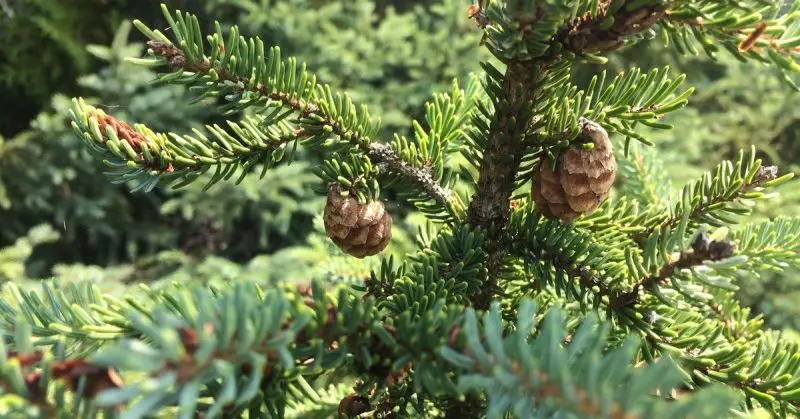
Black Spruce is a small to medium-sized evergreen tree that is native to the cold, northern regions of North America. It is known for its dense, dark green foliage and its adaptability to harsh environments. Black Spruce is commonly found in boggy or wetland areas, making it well-suited for cold, moist climates.
Its needles are short, stiff, and sharp, with a bluish-green hue that becomes more noticeable in the winter months. The tree produces small, cylindrical cones that grow between 1-2 inches in length and mature to a reddish-brown color. The bark is thin, grayish-brown, and often peels in strips.
Black Spruce is hardy in USDA zones 2 through 6, thriving in wet, acidic soils, and full sun to partial shade. It is highly tolerant of cold temperatures and wet conditions, making it ideal for bogs and lowland areas. For proper care, avoid planting in dry or sandy soils, as Black Spruce requires consistent moisture to thrive.
Eucalyptus (Eucalyptus spp.)
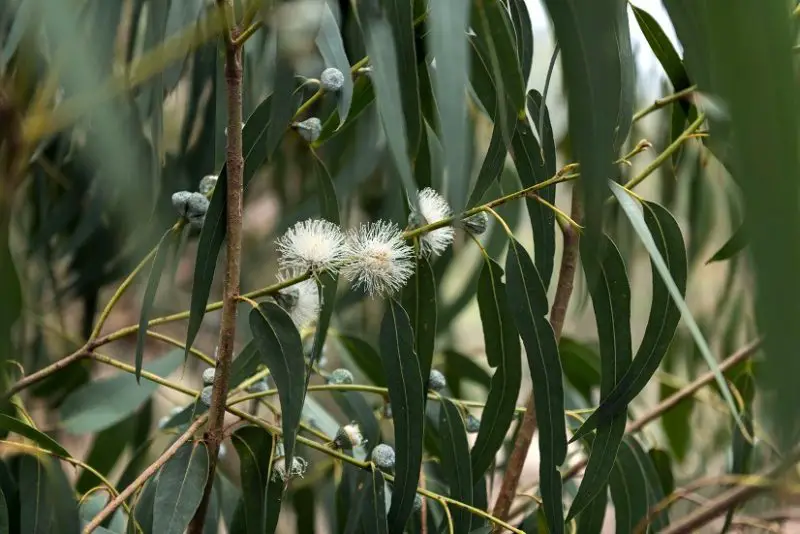
Eucalyptus is a diverse genus of evergreen trees native to Australia and surrounding areas, known for their aromatic leaves and smooth, peeling bark. Eucalyptus trees can vary greatly in size and form, with some species growing as tall as 200 feet, while others are smaller shrubs.
The leaves of most Eucalyptus species are long, lance-shaped, and silver-blue or green, releasing an intense, medicinal fragrance when crushed. The trees produce small, round clusters of flowers, which are typically white, pink, or red, followed by woody, capsule-like fruits. The bark is smooth and peeling, often revealing a colorful layer underneath.
Eucalyptus trees are best suited to USDA zones 8 through 10, preferring full sun and well-drained, slightly acidic soil. They are drought-tolerant and thrive in hot, dry climates. Eucalyptus can be grown as ornamental trees, shade trees, or for oil production, and they require little maintenance once established. Keep in mind that some species may become invasive outside their native range, so it’s important to choose carefully.


